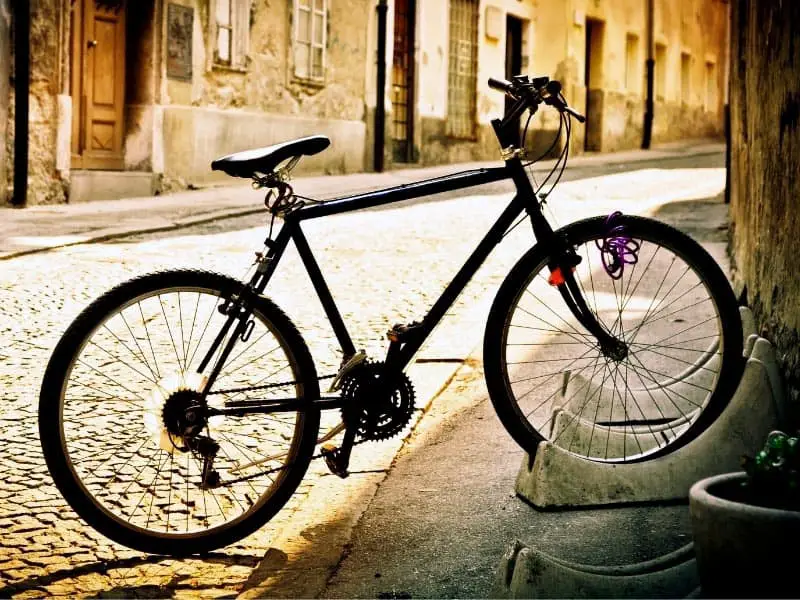As a bike rider who often has to find a place for their bike, you may be wondering why a bicycle can’t stand on its own. There are a few reasons that every bicycle enthusiast should know about.
A bicycle can’t stand on its own due to gravity, weight distribution and tire pressure. The weight of the front and rear side of a bicycle is unevenly distributed due to the gears, chain, handlebars and seat. A stationary bicycle will fall over due to lack of equilibrium. Without a third point of contact, like a kickstand, it will fall over.
I composed this article to help bicyclists understand the physics of their bike and why a bicycle can’t stand on its own.
When you know the science behind it, you are better prepared for taking care of your bike. No longer will you just lean it against any old surface.
It may fall and get damaged. Keep reading to see what forces are working against you in keeping your bike upright.
Recommended Gear
To see all of my up-to-date recommendations for bikes and cycling gear, check out this resource that I made for you!
Table of Contents
Why Can’t A Bike Stand On It’s Own
It is a question that comes up frequently in the cycling world. Why does a bicycle remain balanced when ridden, but falls over without a stand?
The momentum from riding helps keep the bike upright. But, when you are not riding, there are several factors that influence the bike and cause it to fall over.
Without a kickstand or something else to prop it up, your bike will fall over. The reasons mostly involve physics, specifically gravity, weight distribution, and tire pressure.
You need to have a bike stand, kickstand, or some other way to prop up your bicycle. Without this, your bicycle will fall over.
Nobody wants a scratched-up bike, so you go the extra mile to keep your bicycle upright whenever you are not riding.
But why do you have to do this?
There are a few reasons why a bike can’t stand on its own.
Two Wheels Need To Roll
The extra wheel that a tricycle has allows it to stand up. It gives the balance needed. And bicycles, just do not have this.
Two wheels cannot stand up on their own. Two wheels that are moving however, can stand up, as you notice when you ride.
The same is true for any round objects like a tire. Standing along, it will fall over, but when rolling it remains upright.
The same concept applies to two wheels of a bicycle.
The act of pedaling combined with speed keeps the two wheels upright. A bicycle that is moving at more than 5 mph can stay upright.
Providing the ground or surface is smooth, the tires will roll successfully, and the bike will stay up.
Once momentum slows, the bicycle will start to fall. When riding, your pedal actions provide the speed to keep the bicycle moving. So it can stay upright.
A bicycle standing alone is not moving and therefore cannot find any balance.
This is why you have to hold a bicycle to get on and will notice that it tilts easily until you reach a certain speed.
The gyroscope effect explains that a rolling wheel creates enough momentum to resist the pull of gravity, so when moving the two wheels of a bicycle will stay upright.
Where Is The Weight
Looking at a standard object, if the weight is unevenly distributed, you can expect it to fall over.
For example, a top-heavy item on a skinny pole will not be balanced and any shift in the environment will cause the item to fall over.
Balanced weight leads to more stability and bicycles do not have even weight distribution.
The gears and chains to the back of the bike along with the seat add weight. In the front, you only have handlebars and the tires.
So it makes sense that the weight at the back of a bicycle will be greater than the front.
This has advantages in riding, since most cyclists lean forward as they cycle.
Without a rider or momentum, a bicycle will fall over as a result of the uneven weight distribution.
There is a good reason for having a heavier back end. This prevents you from falling over the front of the bicycle when you apply the front brakes.
This however makes the bicycle more susceptible to falling over without support.
What if the weight was evenly distributed? The bike will still fall over because of the other factors involved such as gravity and lack of momentum.
There’s More To Tire Pressure Than You Think
The tire pressure is important for cycling. Tire pressure influences the ride you will have.
Too little air puts the rim of the bike closer to the ground leaving it exposed to dents and damage.
Too much air risks the tire popping should you hit a rock or other object.
The tire pressure also influences the balance on the bicycle.
The ideal tire pressure for bicycles will depend on the type of bike. Racing and street bicycles have thinner tires so will require pressure between 80 and 130 psi.
Mountain bikes have thicker tires and require pressure between 25 and 35 psi.
Whether the tires are thick or thin, a tire filled to optimal pressure levels will still not be able to stand on its own.
If you have a cube, it will not move because it has more points of contact with the ground thanks to the flat surface.
The rounded surface of tires will inevitably cause them to move. As they move, the handlebars of the bike will shift as will the center of gravity, and the bike will fall.
The air pressure in the tires contributes to the roundness and limited contact points with the ground.
Why Does A Bicycle Remain Balanced While Riding But Fall When Stopped
A stationary bicycle will fall over due to lack of equilibrium. An object can stand still and upright if its center of gravity is above the point where it contacts the surface.
If the center of gravity is anywhere else, the object will be pulled down by gravity and fall. It will remain down because in that position it is in equilibrium.
There are now more contact points with the ground and more stability. A bicycle has two points where it touches the ground or surface, the wheels.
This means that it has an unstable support area. The support area for a bicycle is the area between the two points of contact (the tires).
This makes a bicycle’s center of gravity just above this.
The fact that there are moving parts to a bicycle also makes it impossible to stand up on its own.
A non-moving bicycle has no momentum., which means any change in force around the bicycle will shift its equilibrium and cause it to fall over.
A gust of wind or anything that shakes the ground will easily disrupt the balance and with only two contact points, the bike will fall to a place where it will be more stable.
But, when these parts are moving, and the bicycle is moving, the rider can maintain equilibrium and the bike can stay balanced and upright.
How To Make A Bike Stand Up On Its Own
The dynamics of a bicycle will not allow it to stand on its own, at least not for long.
It will always seek to find equilibrium which is laying on the ground.
If rolling, it will remain upright for a time, but only at certain speeds, and once it slows, the bike will fall.
You have to have a way to stand up the bike and a kickstand is the most common way to do this.
Most bikes come with a kickstand for this reason. It provides a third point of contact with the ground and gives balance. The same way the third wheel does for tricycles.
When you do not have a kickstand, you can keep your bicycle upright by turning it over.
Letting it stand on the seat and handlebars, with wheels in the air give more stability.
There are more points of contact with the ground and the surfaces are not rounded.
If you do not have a kickstand, you can also try these alternative ways to support your bike, so it does not fall over.
- Lean the handlebar against a tree or wall
- Lean just the back wheel against a wall
- Leaning two bikes against each other
Final Thoughts
If you have ever asked yourself why a bicycle stays up when riding but why can’t a bicycle stand up on its own, you now have the answer.
The bottom line is that the physics of the bike will not allow it to stand up unsupported.
The weight, tires, and design all influence the center of gravity for a bike and how well it contacts the ground.
With only two wheels to “stand on” the bicycle has no chance of standing up for long.
The wheels will roll, gravitational forces will kick in, balance will shift, and the bicycle will fall.
The bicycle will be in a relaxed place on the ground, no longer fighting gravity, but you may not like the dings and dents.
So, use a kickstand or some other support if you want your bicycle to stand up. It can’t do it alone.


